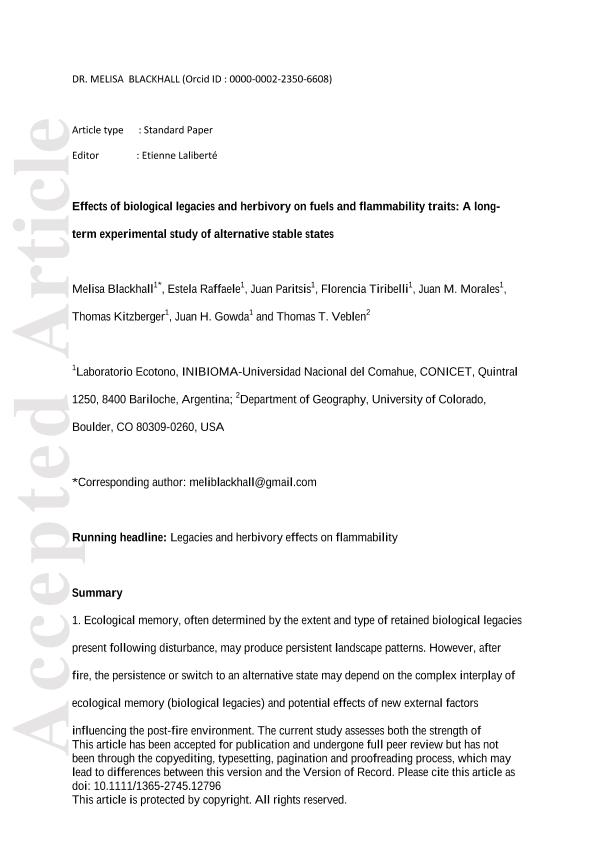Mostrar el registro sencillo del ítem
dc.contributor.author
Blackhall, Melisa

dc.contributor.author
Raffaele, Estela

dc.contributor.author
Paritsis, Juan

dc.contributor.author
Tiribelli, Florencia

dc.contributor.author
Morales, Juan Manuel

dc.contributor.author
Kitzberger, Thomas

dc.contributor.author
Gowda, Juan Janakiram Haridas

dc.contributor.author
Veblen, Thomas

dc.date.available
2018-08-31T20:03:43Z
dc.date.issued
2017-09
dc.identifier.citation
Blackhall, Melisa; Raffaele, Estela; Paritsis, Juan; Tiribelli, Florencia; Morales, Juan Manuel; et al.; Effects of biological legacies and herbivory on fuels and flammability traits: A long-term experimental study of alternative stable states; Wiley Blackwell Publishing, Inc; Journal of Ecology; 105; 5; 9-2017; 1309-1322
dc.identifier.issn
0022-0477
dc.identifier.uri
http://hdl.handle.net/11336/57960
dc.description.abstract
Ecological memory, often determined by the extent and type of retained biological legacies present following disturbance, may produce persistent landscape patterns. However, after fire, the persistence or switch to an alternative state may depend on the complex interplay of ecological memory (biological legacies) and potential effects of new external factors influencing the post-fire environment. The current study assesses both the strength of ecological memory resulting from biological legacies of pre-burn vegetation types as well as post-fire effects of livestock. Following a severe fire in 1999, we set up a network of long-term exclosures to examine the effects of legacies and cumulative herbivory by cattle on fuel types, amounts, distribution, flammability and microenvironmental conditions in two post-fire communities representing alternative fire-driven states: pyrophobic Nothofagus pumilio subalpine forests and pyrophytic Nothofagus antarctica tall shrublands in northwestern Patagonia, Argentina. Our results show that the retained post-disturbance legacies of tall shrublands and subalpine forests largely determine fuel and flammability traits of the post-fire plant communities 16 years after fire. The importance of biological legacies retained from the unburned plant communities was reflected by the substantially higher amounts of total fine fuel, greater vertical and horizontal fuel continuity and the higher temperatures reached during experimental tissue combustion at post-fire shrubland compared to post-fire forest sites. We show that herbivores may produce antagonistic effects on flammability by decreasing tissue ignitability, total fine fuel and litter depth, and disrupting the vertical and horizontal fine fuel continuity, therefore reducing the probability of fire propagation. However, cattle can increase ratios of dead to live fine fuels, reduce soil moisture, and inhibit tree height growth to canopy size, consequently impeding the development of a closed pyrophobic forest canopy. Synthesis. Our results support the hypothesis that biological legacies, most importantly the dominance by pyrophytic woody plants that resprout vigorously vs. the dominance by pyrophobic obligate seeders, favour fuel and flammability characteristics at the community level which reinforce the mechanisms maintaining pyrophytic shrublands vs. pyrophobic forests. Herbivory by introduced cattle can partially blur sharp pyrophobic/pyrophytic state boundaries by promoting the development of novel post-fire transitional states.
dc.format
application/pdf
dc.language.iso
eng
dc.publisher
Wiley Blackwell Publishing, Inc

dc.rights
info:eu-repo/semantics/openAccess
dc.rights.uri
https://creativecommons.org/licenses/by-nc-sa/2.5/ar/
dc.subject
Ecological Memory
dc.subject
Livestock Effects
dc.subject
Non-Resprouting Species
dc.subject
Nothofagus Spp.
dc.subject
Plant Population And Community Dynamics
dc.subject
Plant&Ndash;Herbivore Interactions
dc.subject
Pyrophobic Forests
dc.subject
Pyrophytic Shrublands
dc.subject
Resprouting
dc.subject.classification
Otras Ciencias Biológicas

dc.subject.classification
Ciencias Biológicas

dc.subject.classification
CIENCIAS NATURALES Y EXACTAS

dc.title
Effects of biological legacies and herbivory on fuels and flammability traits: A long-term experimental study of alternative stable states
dc.type
info:eu-repo/semantics/article
dc.type
info:ar-repo/semantics/artículo
dc.type
info:eu-repo/semantics/publishedVersion
dc.date.updated
2018-08-31T13:47:49Z
dc.journal.volume
105
dc.journal.number
5
dc.journal.pagination
1309-1322
dc.journal.pais
Reino Unido

dc.journal.ciudad
Londres
dc.description.fil
Fil: Blackhall, Melisa. Consejo Nacional de Investigaciones Científicas y Técnicas. Centro Científico Tecnológico Conicet - Patagonia Norte. Instituto de Investigaciones en Biodiversidad y Medioambiente. Universidad Nacional del Comahue. Centro Regional Universidad Bariloche. Instituto de Investigaciones en Biodiversidad y Medioambiente; Argentina
dc.description.fil
Fil: Raffaele, Estela. Consejo Nacional de Investigaciones Científicas y Técnicas. Centro Científico Tecnológico Conicet - Patagonia Norte. Instituto de Investigaciones en Biodiversidad y Medioambiente. Universidad Nacional del Comahue. Centro Regional Universidad Bariloche. Instituto de Investigaciones en Biodiversidad y Medioambiente; Argentina
dc.description.fil
Fil: Paritsis, Juan. Consejo Nacional de Investigaciones Científicas y Técnicas. Centro Científico Tecnológico Conicet - Patagonia Norte. Instituto de Investigaciones en Biodiversidad y Medioambiente. Universidad Nacional del Comahue. Centro Regional Universidad Bariloche. Instituto de Investigaciones en Biodiversidad y Medioambiente; Argentina
dc.description.fil
Fil: Tiribelli, Florencia. Consejo Nacional de Investigaciones Científicas y Técnicas. Centro Científico Tecnológico Conicet - Patagonia Norte. Instituto de Investigaciones en Biodiversidad y Medioambiente. Universidad Nacional del Comahue. Centro Regional Universidad Bariloche. Instituto de Investigaciones en Biodiversidad y Medioambiente; Argentina
dc.description.fil
Fil: Morales, Juan Manuel. Consejo Nacional de Investigaciones Científicas y Técnicas. Centro Científico Tecnológico Conicet - Patagonia Norte. Instituto de Investigaciones en Biodiversidad y Medioambiente. Universidad Nacional del Comahue. Centro Regional Universidad Bariloche. Instituto de Investigaciones en Biodiversidad y Medioambiente; Argentina
dc.description.fil
Fil: Kitzberger, Thomas. Consejo Nacional de Investigaciones Científicas y Técnicas. Centro Científico Tecnológico Conicet - Patagonia Norte. Instituto de Investigaciones en Biodiversidad y Medioambiente. Universidad Nacional del Comahue. Centro Regional Universidad Bariloche. Instituto de Investigaciones en Biodiversidad y Medioambiente; Argentina
dc.description.fil
Fil: Gowda, Juan Janakiram Haridas. Consejo Nacional de Investigaciones Científicas y Técnicas. Centro Científico Tecnológico Conicet - Patagonia Norte. Instituto de Investigaciones en Biodiversidad y Medioambiente. Universidad Nacional del Comahue. Centro Regional Universidad Bariloche. Instituto de Investigaciones en Biodiversidad y Medioambiente; Argentina
dc.description.fil
Fil: Veblen, Thomas. University of Colorado; Estados Unidos
dc.journal.title
Journal of Ecology

dc.relation.alternativeid
info:eu-repo/semantics/altIdentifier/doi/https://dx.doi.org/10.1111/1365-2745.12796
dc.relation.alternativeid
info:eu-repo/semantics/altIdentifier/url/https://besjournals.onlinelibrary.wiley.com/doi/abs/10.1111/1365-2745.12796
Archivos asociados
